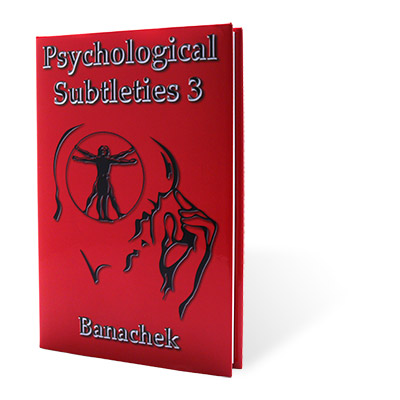At the time, Psychological Subtleties 2 was written, Banachek had a large amount of additional material, including commercial routines and tips from friends, that in total would have made that book too large to fit the format of the series. Although Psychological Subtleties 2 was acclaimed as the “Best Book of 2007,” we withheld some strong material with the intent of publishing a substantive companion to the series in a separate book. What you are holding is the culmination of a lifetime of research and development, through live performances from Banachek with contributions from an eclectic group of colleagues and professionals around the globe who understood the value and impact of the ideas from the first book.
The “Psychological Subtleties” series is considered by many to be the ultimate mentalism toolbox. Rarely do you find a magician, particularly in the mentalism community, who does not use some idea, trick or routine that has been inspired by Banachek’s magical philosophy, performances, or writings.
With this third book he continues to inspire readers with the “Psychological Subtleties” series by offering additional fresh and creative ideas along with full routines from both himself and his friends from around the globe. Here you will find routines from Paul Alberstat, Sean Waters, Robert Domenech, Leonardo Silverio, Colin McLeod, Andrew Gerard, Marc Spelmann, Peter Nardi, Don Marco, Craig Leonard, Peter Arcane, Brad Henderson, Mark Roberts, Leo Boudreau, Jonathan Grant, Tony Binarelli, Docc Hilford, Kenton Knepper, Michael Murray, Richard Busch, Bryan Quinn, Francis J. Menotti, Ravi, Raj Madhok, Greg Arce, David Penn, and Joseph Atmore.
Psychological Subtleties 3 has dozens of routines filled with layers of subtleties and psychological principles for your mentalism/magic toolbox.
In the Introduction to Psychological Subtleties 3, the living legend and international man of mystery, David Berglas talks about his relationship with Banachek and his respect for his skills.
Chapter One – Subtle Dealing with Difficult Spectators: Have you ever had your performance disrupted by a cell phone? Have you ever had a spectator refuse to reveal their thought-of number/card/item? Have you ever had a spectator deliberately lie to you about what they were thinking? This chapter deals with preventing and creating the perfect performance situation so these will never happen to you again.
Chapter Two – Subtle Creating the Perfect Situation: In this chapter you will learn how in the first two minutes to make a perfect impression for the rest of your show, equivoque subtleties, plus you will learn two amazing principles where you will appear to know intimate details about complete strangers. Why do psychological subtleties work for some performers but not for others? Banachek talks in this chapter about how conviction is the key. This chapter also includes how to use politically correct statements in your performance to influence your volunteer’s thoughts and a wonderful pseudo explanation to your audience of how you can made them think of a specific vegetable.
Chapter Three – Subtle Verbal: This is all about verbal “dual reality” and how to be both right and wrong at the same time. It is also how to phrase something so it is understood differently by your volunteer than by the audience. A couple effects from this chapter include “Picture Perfect” wherein a spectator is able to describe the color of a shirt, the color of the eyes, the time on a clock and the name of an individual in a picture without ever having seen it. “Ultimate Imagination” is a coin visualization routine wherein the performer is able to tell a spectator which invisible coin they are thinking of and which hand holds the coin.
Chapter Four – Subtle Drawings: Drawn from Banachek’s professional repertoire, this chapter reveals one of his favorite ploys: the Cheshire Cat Principle. In this effect you know how a spectator is drawing a picture in their mind and also the fact that they left out a major detail in their drawing. Among other effects and principles in this chapter, you will learn a multiple picture duplication, another picture duplication using nothing but psychological subtleties, and a routine where the performer predicts a picture drawn by a spectator.
Chapter Five – Subtle Letters: This chapter revisits Banachek’s principle where spectators mix up letters in a word and think of one and you know what it is. The first two effects take this principle to a new level by allowing you to not only know the letter, but also animals, places, people, and other specific things that reside in the spectator’s minds. The chapter closes with a very diabolical book test.
Chapter Six – Subtle Cards: This chapter deals with how to use various psychological principles to force playing cards.
Chapter Seven – Subtle Dates: Four spectators think of a date on the calendar. The performer correctly identifies the dates that three spectators are thinking of and concludes with a startling revelation of a fourth spectator’s thought. This was originally sold for $20.00 as Kenton’s Kalendar. Also included in this chapter are two different methods for revealing the day of the week in a calendar year.
Chapter Eight – Subtle Psychokinesis: When it comes to metal bending, it is imperative that the audience sees the participant feeling the psychokinesis (PK) happening. Do you want to make spectators feel hot, cold or feel taps/touches or feel metal bend in a bag? This chapter goes into detail on how to create these impressions both psychologically and physically.
Chapter Nine – Subtle Telephone: Play a dramatic game of Russian Roulette, reveal a song that a spectator is thinking of, and detect a lie all while on the other end of the telephone.
Chapter Ten – Subtle Numbers: This chapter revisits Banachek’s “Reversal” principle that gives it meaning and applies it to an ingenious book test. We also take an in depth visit to the “Gray Elephant in Denmark” principle and give it new clothing. Also included in this chapter is a prediction effect that culminates in creating a souvenir gift origami raven using psychokinesis.
Chapter Eleven – Subtle Paradox: Using the written word you are able to predict which coin will be chosen and whether it is heads or tails; which invisible M&M will be selected and whether or not it will have nuts; whether medication is taken for two weeks or four days, and; successfully predict the make of a car and whether or not it is a four-wheel drive. You will also be able to show that you knew the spectator’s Personal Identification Number (PIN) in advance and in another effect, how to create two separate realities at the same time.
Chapter Twelve – Subtle Perceptions: Optical illusions are applied to psychic effects in this chapter. For example George Washington on a one dollar bill reveals whether or not a volunteer is telling the truth and in a separate effect, two spectators read the performer’s thoughts by staring at a third spectator’s scribble.
Chapter Thirteen – Subtle Betting: You will learn two different methods that will make it appear that you predicted the correct results of the lottery plus a clever way to show that you correctly bet and won on a sporting event.
Chapter Fourteen – Subtle Dunninger: This chapter reveals some of the bold subtleties used by Dunninger on stage and behind the microphone on his number one rated television show.
Chapter Fifteen – Subtle News: Banachek reveals one of his most coveted methods for predicting the headlines of the newspaper.
Pages: 226 – Hardbound with Dust Jacket

Psychological Subtleties 3 (PS3) by Banachek – Book
 Phil Plus 2 by Trevor Duffy
£ 21.37
Phil Plus 2 by Trevor Duffy
£ 21.37
 Quick and Effective Cold Reading by Richard Webster - Book
£ 38.46
Quick and Effective Cold Reading by Richard Webster - Book
£ 38.46
Psychological Subtleties 3 (PS3) by Banachek – Book
£ 55.56
12 in stock
Additional information
| Weight | 1.075 kg |
|---|






Reviews
There are no reviews yet.